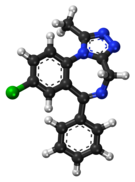 | |
 | |
| Clinical data | |
|---|---|
| Pronunciation | Alprazolam /ælˈpræzəlæm/ or /ælˈpreɪzəlæm/, Xanax /ˈzænæks/ |
| Trade names | Xanax, Xanor, Niravam, others |
| AHFS/Drugs.com | Monograph |
| MedlinePlus | a684001 |
| License data |
|
| Pregnancy category |
|
| Dependence liability | High[2] |
| Routes of administration | By mouth |
| Drug class | Benzodiazepine |
| Legal status | |
| Legal status |
|
| Pharmacokinetic data | |
| Bioavailability | 80–90% |
| Protein binding | 80% |
| Metabolism | Liver, via cytochrome P450 3A4 |
| Metabolites | alpha-hydroxyalprazolam, 4-hydroxyalprazolam, beta-hydroxyalprazolam |
| Onset of action | less than an hour[3] |
| Elimination half-life | Immediate release: 11–13 hours[4] Extended release: 11–16 hours[4] |
| Duration of action | 6 hours[3] |
| Excretion | Kidney |
| Identifiers | |
| |
| Chemical and physical data | |
| Formula | C17H13ClN4 |
| Molar mass | 308.77 g·mol−1 |
| 3D model (JSmol) | |
| |
| |
| (verify) | |
Alprazolam, sold under the brand name Xanax, among others, is a short-acting benzodiazepine.[7] It is most commonly used in short term management of anxiety disorders, specifically panic disorder or generalized anxiety disorder (GAD).[5] Other uses include the treatment of chemotherapy-induced nausea, together with other treatments.[4] GAD improvement occurs generally within a week.[8][9] Alprazolam is generally taken by mouth.[4]
Common side effects include sleepiness, depression, headaches, feeling tired, dry mouth, and memory problems.[4] Some of the sedation and tiredness may improve within a few days.[10] Due to concerns about misuse, some do not recommend alprazolam as an initial treatment for panic disorder.[11] Withdrawal or rebound symptoms may occur if use is suddenly decreased;[4] gradually decreasing the dose over weeks or months may be required.[8] Other rare risks include suicide, possibly due to loss of inhibition.[12] Alprazolam, like other benzodiazepines, acts through the GABAA receptor.[4]
Alprazolam was patented in 1971 and approved for medical use in the United States in 1981.[4][13] Alprazolam is a Schedule IV controlled substance and is a common drug of abuse.[2][14] It is available as a generic medication.[15] The wholesale cost in the United States is less than US$0.03 per dose as of 2018.[16] In 2017, it was the 21st most commonly prescribed medication in the United States, with more than 25 million prescriptions.[17][18]
References edit
- ^ a b "Alprazolam Use During Pregnancy". Drugs.com. 4 May 2020. Archived from the original on 20 June 2020. Retrieved 8 June 2020.
- ^ a b Ait-Daoud N, Hamby AS, Sharma S, Blevins D (2018). "A Review of Alprazolam Use, Misuse, and Withdrawal". Journal of Addiction Medicine. 12 (1): 4–10. doi:10.1097/ADM.0000000000000350. PMC 5846112. PMID 28777203.
- ^ a b Lilley, Linda Lane; Snyder, Julie S.; Collins, Shelly Rainforth (2016). Pharmacology for Canadian Health Care Practice. Elsevier Health Sciences. p. 329. ISBN 9781771720663. Archived from the original on 22 January 2019. Retrieved 22 January 2019.
- ^ a b c d e f g h i American Society of Health-System Pharmacists (13 November 2017). "Alprazolam Monograph for Professionals". Drugs.com. Archived from the original on 7 December 2010. Retrieved 25 October 2018.
- ^ a b "Alprazolam Tablets, USP". dailymed.nlm.nih.gov. July 2017. Archived from the original on 14 July 2020. Retrieved 25 October 2018.
- ^ "WHOCC - ATC/DDD Index". www.whocc.no. Archived from the original on 3 August 2020. Retrieved 9 September 2020.
- ^ Goldberg, Raymond (2009). Drugs Across the Spectrum. Cengage Learning. p. 195. ISBN 9781111782009. Archived from the original on 4 June 2020. Retrieved 24 August 2017.
- ^ a b Verster JC, Volkerts ER (2004). "Clinical pharmacology, clinical efficacy, and behavioral toxicity of alprazolam: a review of the literature". CNS Drug Reviews. 10 (1): 45–76. doi:10.1111/j.1527-3458.2004.tb00003.x. PMC 6741717. PMID 14978513.
- ^ Tampi RR, Muralee S, Weder ND, Penland H, eds. (2008). Comprehensive Review of Psychiatry. Philadelphia, PA: Wolters Kluwer/ Lippincott Williams & Wilkins Health. p. 226. ISBN 978-0-7817-7176-4. Archived from the original on 19 March 2017. Retrieved 13 March 2016.
- ^ Pavuluri MN, Janicak PG, Marder SR (2010). Principles and Practice of Psychopharmacotherapy (5th ed.). Philadelphia, PA: Wolters Kluwer Health/ Lippincott Williams & Wilkins. p. 535. ISBN 978-1-60547-565-3. Archived from the original on 17 July 2020. Retrieved 13 March 2016.
- ^ Moylan S, Giorlando F, Nordfjærn T, Berk M (March 2012). "The role of alprazolam for the treatment of panic disorder in Australia" (PDF). The Australian and New Zealand Journal of Psychiatry. 46 (3): 212–24. doi:10.1177/0004867411432074. PMID 22391278. Archived (PDF) from the original on 22 April 2017. Retrieved 27 October 2012.
- ^ Dodds TJ (March 2017). "Prescribed Benzodiazepines and Suicide Risk: A Review of the Literature". The Primary Care Companion for CNS Disorders. 19 (2). doi:10.4088/PCC.16r02037. PMID 28257172.
- ^ Fischer, Jnos; Ganellin, C. Robin (2006). Analogue-based Drug Discovery. John Wiley & Sons. p. 536. ISBN 9783527607495. Archived from the original on 24 February 2020. Retrieved 2 March 2019.
- ^ Malamed, Stanley F. (2009). Sedation: A Guide to Patient Management. Elsevier Health Sciences. p. 105. ISBN 978-0323075961. Archived from the original on 26 October 2018. Retrieved 26 October 2018.
- ^ "In Pictures: The Most Popular Prescription Drugs". Forbes. Archived from the original on 12 January 2020. Retrieved 16 June 2015.
- ^ "NADAC as of 2018-10-24". Centers for Medicare and Medicaid Services. Archived from the original on 24 June 2019. Retrieved 26 October 2018.
- ^ "The Top 300 of 2020". ClinCalc. Archived from the original on 18 March 2020. Retrieved 11 April 2020.
- ^ "Alprazolam Drug Usage Statistics". ClinCalc. Archived from the original on 12 April 2020. Retrieved 11 April 2020.